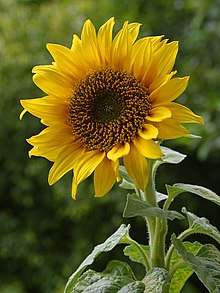Forb
A forb or phorb is a herbaceous flowering plant that is not a graminoid (grass, sedge, or rush). The term is used in biology and in vegetation ecology, especially in relation to grasslands[1] and understory.

Etymology
"Forb" is derived from Greek phorbḗ (φορβή), meaning "pasture" or "fodder".[2][3] The hellenic spelling "phorb" is sometimes used, and in older usage this sometimes includes graminids and other plants currently not regarded as forbs.
Forbs and guilds
Forbs are members of a guild—a group of plant species with broadly similar growth form. In certain contexts in ecology, guild membership may often be more important than the taxonomic relationships between organisms.
Forbs in informal classification
In addition to its use in ecology, the term "forb" may be used for subdividing popular guides to wildflowers, distinguishing them from other categories such as grasses, sedges, shrubs, and trees.
Some examples of forbs are clovers, sunflowers, daylilies, and milkweed.
See also
References
- Schröder, Hans (2009). Grasslands: Ecology, Management and Restoration. Commack, N.Y: Nova Science Publishers. ISBN 1-60692-024-3.
- Jaeger, Edmund C. (1959). A source-book of biological names and terms. Springfield, Ill: Thomas. ISBN 0-398-06179-3.
- Scott, Robert Pickett; Henry, George (2007). Liddell and Scott's Greek-English Lexicon, Abridged: Original Edition, republished in larger and clearer typeface. Simon Wallenburg Press. ISBN 1-84356-026-7.
External links
- United States Department of Agriculture Natural Resources Conservation Service link to Growth habits Codes and Definitions.